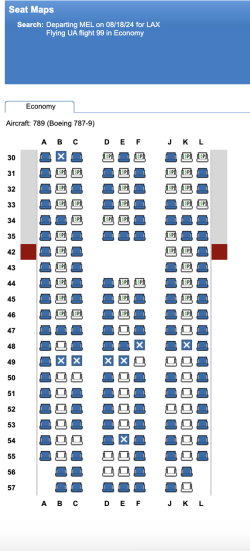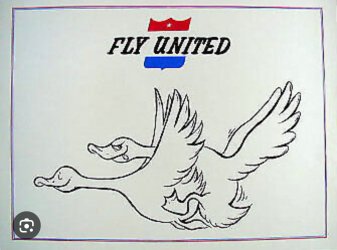- Joined
- Nov 16, 2004
- Posts
- 48,859
- Qantas
- Platinum
- Virgin
- Platinum
- Oneworld
- Emerald
Okay, to quash this allegation of bias, let's look at the reverse case. Melbourne to Los Angeles. UA operates 4x a week on a 787 while Qantas does it daily with 787/A380.Firstly you're comparing a daily 777 service to a 3 times weekly 787 service.


EF is really quite accurate post departure - for the airlines that allow seat maps to be published after departure. Before departure - agree - depends on the airline and we all know things jump around the closer you get to check in cut off.Next you're using EF seatmap which really means absolutely nothing for loads.
How about you look at the post above you before making these unhelpful comments? UA99 to LAX today - currently in the air is half empty and I have included the seatmap for that.If OP was to make a more coherent argument he’d look at post departure maps. But when tr…ing , the more controversial the better.
Nice edit in that post, following dajop's comment.How about you look at the post above you before making these unhelpful comments? UA99 to LAX today - currently in the air
The post-departure seatmap for today's UA99 in that post was always there. Emphasis added because clearly some people didn't notice.Nice edit in that post, following dajop's comment.
Posts overlap, when 3 mins apart. It’s not instantaneous to post a reply. I was looking at UA 870 on the 15th whilst drafting my post. Whilst QF73 was fuller UA 870 on that date wasn’t particularly empty and full in business.How about you look at the post above you before making these unhelpful comments? UA99 to LAX today - currently in the air is half empty and I have included the seatmap for that.
So what exactly is the problem or more precisely, what is your point?UA have not only failed with their capacity dumping but are also under their revised schedule still flying planes half empty to/from Australia whether that be planes currently in the air or seatmaps for the next 2-3 days, while Qantas' flights are full.
If someone wants to fly economy that means you’re going to have a quite a lot of space around you. That’s a big plus.
Do you think privately owned airlines from capitalist countries will be happy if there’s a lot of vacant space in the economy cabin? This is not petro dollar fairyland and it’s an indicator that the service is not commercially viable since Australians and arguably Americans are preferring Qantas over UA in droves.So again I ask you, what’s the problem?
Again, you haven’t actually identified a problem, especially for most of us and AFF who are airline consumers. I don’t care if the route I am travelling on is profitable or not for the airline. I don’t care if it’s government subsidised or not. Just get me where I want to go, when I want to go, for a reasonable price and reasonable comfort.Do you think privately owned airlines from capitalist countries will be happy if there’s a lot of vacant space in the economy cabin? This is not fairyland and it’s an indicator that the service is not commercially viable since Australians and arguably Americans are preferring Qantas over UA.
In fact I expect a third tranche of UA Australia cuts; by the end of 2025 I think all of UA’s flights from Australia to LAX will be axed and UA’s SYD-SFO downgraded to a 787 and reduced frequency. That leaves only 3 daily UA flights to Australia to one destination.
There’s no problem. There’s only facts. The fact is that every single part of the opinionated December article you linked and quoted in post #1 is now no longer true and we’re witnessing a spectacular rise and fall situation. Not only are they no longer the largest carrier on the Australia-USA corridor, but the other part of that article is also invalidated:Again, you haven’t actually identified a problem
Business travel is roughly flat on pre-pandemic levels, but Mr Stevens said United was capitalising on traveller discontent.
“I won’t speak for the other US carriers, but I think that they’re choosing United where they may have picked an Australian carrier in the past,” he said.
“If we can give them a great experience on that first trip, I think we feel very confident they’re going to stay. They’re going to continue to choose United in the future.”
Do you really mean you’re still harking back to that article of 9 months ago? As if things in the airline industry don’t change every day?The fact is that every single part of the opinionated December article you linked and quoted in post #1 is now no longer true and we’re witnessing a spectacular rise and fall situation.

AFF Supporters can remove this and all advertisements
It really doesn’t. A large amount of vacant space in the UA economy cabin while QF loads are 100% simply suggests that the UA product and option is unpopular - not only with Australians but likely also with the Americans. Qantas is arguably a well recognised and respected brand in the USA and we’re seeing that reflected in demand. May QF’s huge margin against UA in this market continue to increase.Every time you post, it highlights that United will be a better choice to the USA for consumers than Qantas. Goand
No, it reflects over capacity. You can’t have it both ways - either they are capacity dumping and therefore going to have a lot of space or they’re just running their planes normally and it’s not a popular product.A large amount of vacant space in the UA economy cabin while QF loads are 100% simply suggests that the UA product and option is unpopular -
That’s actually where the wheels fall off the original hypothesis. The fares still haven’t dropped back to pre Covid numbers. So UA presumably thought they could dump a bunch of ex China capacity on Oz but maintain (gouge) fares due to high demand. They probably didn’t need to fill every plane to still make some money.Here endeth my contribution to this thread but keep highlighting United’s frequent, spacious and less expensive product.
As of now, UA can barely fill a 787 economy cabin above 50% on a route they fly 4x weekly while Qantas flies daily on the same route and have loads of near 100% on an A380 in the same cabin. How does that align with the above quote?
That’s because they picked up the Pan Am routes!*Post Pan Am


